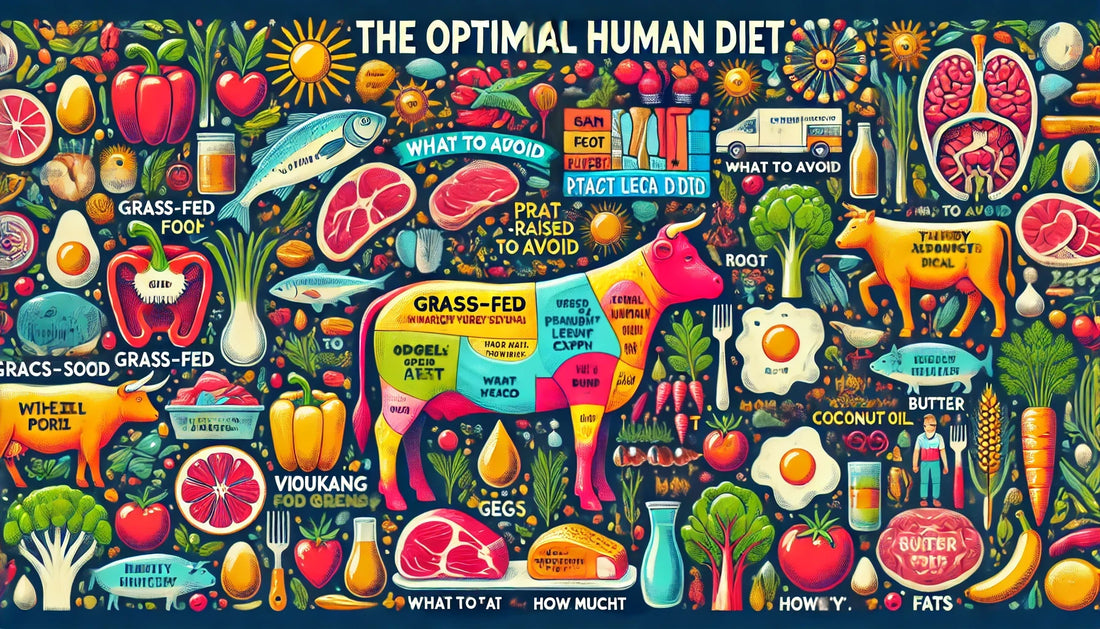
The Optimal Human Diet
Share
Introduction
The optimal human diet is designed to maximize health and well-being by focusing on natural, nutrient-dense foods. This diet emphasizes animal-based products and avoids processed foods and certain plant-based items that may contain toxins. In this article, we will explore the components of the optimal human diet, including what to eat, what to avoid, and the recommended proportions of different food groups.
What to Eat
A diet centered around animal products emphasizes the consumption of meat, preferably from grass-fed beef. It may also incorporate pasture-raised pork, chicken, turkey, and eggs (all free from corn and soy), as well as organs, fruits, honey, and raw dairy.
Animal-Based Foods
Animal-based foods are the cornerstone of the optimal human diet. These foods provide essential nutrients that are often more bioavailable than those found in plant-based sources.
- Grass-fed Beef
- Pasture-raised Pork
- Pasture-raised Chicken
- Pasture-raised Turkey
- Organ Meats (Liver, Spleen, Kidney, Heart, Thymus)
- Raw Dairy
- Corn/Soy-free Eggs
- Wild-caught Fish
- Bone Broth
- Collagen Source
Fruits
Fruits, particularly sweet fruits, are included in moderation. They provide essential vitamins and antioxidants.
- Banana
- Berries
- Mango
- Oranges
- Papaya
- Pineapple
- Watermelon
Non-Sweet Fruits and Vegetables
Non-sweet fruits and certain vegetables are included for their fiber and nutrient content.
- Avocado
- Cucumber
- Olives
- Pumpkin
- Squash
- Zucchini
Healthy Fats
Animal fats are preferred over all plant-based oils, including olive or avocado oil.
- Grass-fed Butter / Ghee
- Tallow/Suet
- Olive Oil
- Avocado Oil
- Coconut Oil
Other Foods
Additional foods that can be included in the optimal human diet for their health benefits:
- Raw, Local Honey
- White Rice
- Roots/Tubers (Carrots, Yams, Sweet Potato)
- Herbs (Basil, Dill, Mint, Oregano, Parsley, Rosemary, Thyme)
- Fermented Vegetables (Pickles, Sauerkraut)
- Low Metal Fish (Anchovies, Sardines, Shellfish, Wild Salmon)
- Ceylon Cinnamon
What to Avoid
To maintain long-term health, it's crucial to steer clear of certain foods and ingredients that can be harmful or less beneficial.
High Toxic Foods
These foods should be avoided due to their high toxicity levels.
- Most Leaves & Seeds
- Seed Oils (Canola, Corn, Peanut, Safflower, Soybean, Sunflower)
- Processed Sugars
- Grains (Amaranth, Millet, Oats, Quinoa, Wheat)
- Nightshades (Chili Peppers, Eggplant, Goji Berries, Peppers, Tomato, White Potato)
- High Heavy Metal Fish (Halibut, King Mackerel, Sea Bass, Tuna)
Medium Toxic Foods
These foods are moderately toxic and should be limited or avoided depending on individual tolerance.
- Brassica Vegetables (Bok Choy, Broccoli, Brussels Sprouts, Cabbage, Cauliflower, Kale, Radishes, Watercress)
- Legumes (Green Beans, Kidney Beans, Lentils, Peanut, Peas, Soybeans)
- Spices (Black/White Pepper, Cardamom, Cassia Cinnamon, Coriander, Cumin, Paprika, Turmeric)
- Nuts (Almond, Brazil, Cashew, Macadamia, Walnut)
Low Toxic Foods
These foods are generally safe but should still be consumed in moderation.
- Grains (Coffee)
- Chocolate
- Mushrooms
- Alliums (Garlic, Leek, Onion)
- Non-leafy Vegetables (Beets, Chard, Asparagus, Celery)
- Leafy Vegetables (Arugula, Green Leaf, Mixed Greens, Romaine)
How Much to Eat
Balancing the intake of different macronutrients is key to following the optimal human diet. Here's a general guideline:
Caloric Distribution
- Calories from Fat: 50-70%
- Calories from Protein: 20-30%
- Calories from Carbohydrates: 0-20%
Organ Meats
Incorporate 1-2 ounces of liver daily, along with a few ounces of spleen, kidney, heart, thymus, and other organs weekly (or equivalent amounts in desiccated organ supplements).
Conclusion
The optimal human diet centers around whole, nutrient-dense foods, primarily from animal sources, while avoiding processed foods and certain plant-based items. By following these guidelines, you can achieve better health and well-being.
